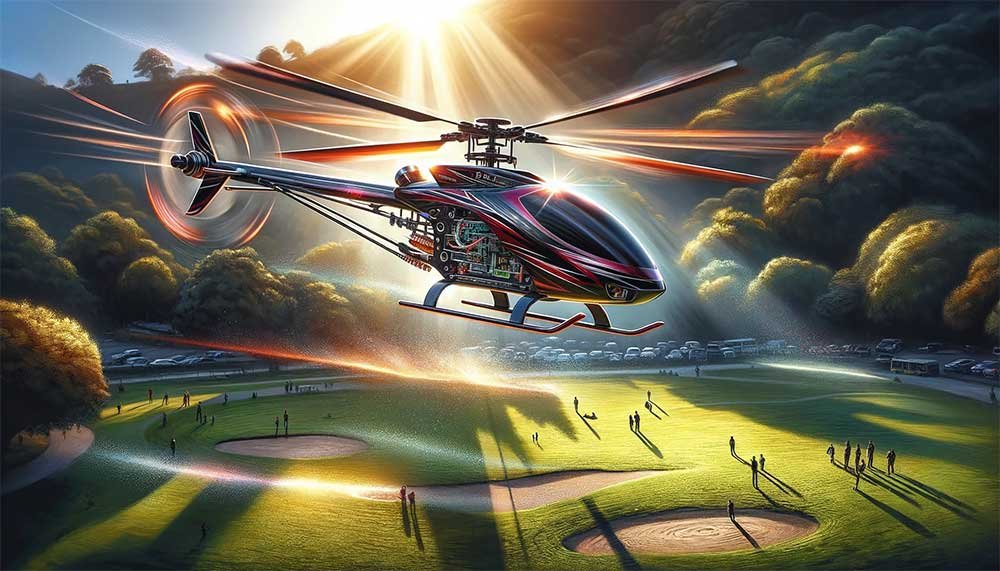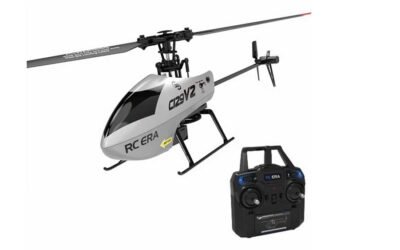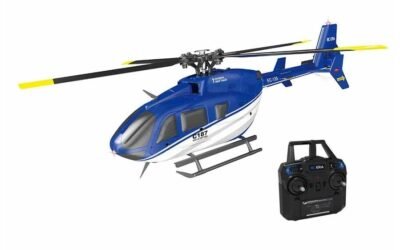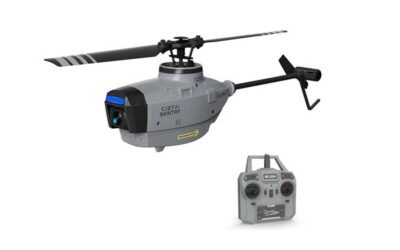Engaging Skies: The Thrill of 4-Channel RC Helicopters
Learning to fly a 4-channel RC helicopter involves mastering throttle, elevator, aileron, and rudder controls for smooth, controlled flights. Essential for beginners.
“With each flight, a pilot’s bond with their helicopter strengthens.”

Section 1: Sky-High Basics
What Makes 4-Channel RC Helicopters Unique
4-channel RC helicopters represent a fascinating blend of engineering and entertainment, a real treat for hobbyists who appreciate precision and control. Unlike their simpler 2 or 3-channel counterparts, 4-channel models offer a richer, more nuanced flying experience. The four channels refer to the four types of controls available: throttle, elevator, aileron, and rudder.
Let’s break it down: the throttle controls vertical lift, dictating how high your helicopter soars. The elevator tilts the craft forward or backward, influencing speed and direction. The aileron adds a twist, literally, by tilting the helicopter side to side, making those nifty banking turns possible. And lastly, the rudder? It’s all about the spin, letting you rotate the helicopter on its axis. This quartet of controls allows for a symphony of movements, from gentle glides to heart-stopping dives, making each flight a unique narrative.
A Brief History of RC Helicopters
The journey of RC helicopters is as dynamic as their flight. Originally emerging as simple toys with limited maneuverability, they’ve evolved dramatically. In the early days, these flying machines were rudimentary, often tethered to a control box and offering limited joy. But as technology advanced, so did the complexity and capabilities of these miniature copters. Today’s 4-channel RC helicopters are the descendants of those early models, boasting advanced mechanics and electronics. They’re no longer just toys but sophisticated hobbyist gear, capable of intricate aerobatics and precise control, embodying the dreams of every aspiring pilot.
Section 2: Technical Tango
The Heart of the Helicopter: Understanding the Mechanics
Diving into the mechanics of a 4-channel RC helicopter is like exploring the inner workings of a Swiss watch – intricate, fascinating, and precise. At the heart of these mechanical marvels are the motors, often brushless for enhanced efficiency and longevity. These motors power the rotors – the main rotor for lift and the tail rotor for stability and direction.
But the real magic lies in the gyroscope. This little gem of technology is what keeps your helicopter from turning into an unguided missile. Gyroscopes help stabilize the helicopter, ensuring smooth flights and even smoother landings. They’re the unsung heroes, constantly adjusting to wind and motion, keeping your helicopter level and obedient to your commands.
Remote Control Mastery
Now, let’s talk about the wands of this wizardry: the remote controls. These aren’t just simple “push-to-go” gadgets. A 4-channel controller is a complex device that requires skill and practice to master. Each stick and button is calibrated for precision, allowing pilots to weave their helicopters through the air with grace and accuracy.
Understanding the subtleties of these controllers is crucial. A gentle nudge on the throttle can mean the difference between a steady ascent and a rocket launch. The aileron and elevator controls demand finesse – too much, and your helicopter is doing acrobatics; too little, and it’s more of a floating duck than an agile bird. And mastering the rudder? That’s where the artistry comes in, allowing for those breathtaking spins and sharp turns that make 4-channel RC helicopters a joy to fly.
In the world of RC helicopters, the technical dance between machine and controller is where the magic happens, turning flights into experiences and pilots into maestros of the sky.

Section 3: Buyer’s Guide to 4-Channel Mastery
Choosing Your Wingman
Selecting a 4-channel RC helicopter is akin to choosing a dance partner – it needs to match your rhythm and style. For those new to this aerial ballet, here’s a guide to picking your perfect wingman. Firstly, consider the build quality. A sturdy helicopter withstands those inevitable beginner’s crashes. Next, ponder the size. Generally, larger models are more stable and easier to control outdoors, while smaller ones are perfect for indoor adventures.
But let’s talk tech. The gyroscope technology is a must for stability, especially for new pilots. Also, look at the battery life and charging time – because nobody likes a party pooper that runs out of juice too soon. Advanced flyers might want to consider models with upgradable parts for customized flying experiences. And lastly, the control range – because you don’t want your new buddy flying off into the sunset without you.
Price vs. Performance
Now, onto the classic debate: price versus performance. For beginners, it’s tempting to go for cheaper models, but remember, you often get what you pay for. A slightly higher investment can get you a model that’s not only more durable but also provides a better flying experience – think smoother controls and fewer hair-pulling moments.
For the seasoned pilots, shelling out a few extra bucks can mean access to a world of features – advanced gyroscopes, longer battery life, and enhanced control features. These investments often translate into more precise, exhilarating flights. However, the golden rule remains: balance your budget with your needs. Don’t mortgage the house for a helicopter, but don’t settle for a dud that’ll spend more time in repairs than in the air.
Section 4: The Flight School
Taking Off: Basic Flying Techniques for Beginners
Welcome to flight school, future pilots! First lesson: taking off. Start with a level surface and gradually increase the throttle. The key here is patience – let the helicopter lift off slowly. Once airborne, practice hovering by maintaining a stable altitude. Remember, gentle movements are the secret – think of it as a slow dance, not a rock concert.
Next up, basic maneuvers. Start with simple forward and backward movements, then side-to-side. These exercises aren’t just about moving around; they’re about understanding the feel of the controls. It’s like learning to drive – at first, it feels like patting your head and rubbing your stomach at the same time, but soon it becomes second nature.
Advanced Aerobatics: Tips for Intermediate and Advanced Maneuvers
Ready to level up? Let’s dive into advanced aerobatics. The first trick in your arsenal should be the bank turn. It’s all about combining aileron and elevator controls to execute a smooth, curved path. Think of it as a graceful ballet spin, not a clumsy pirouette.
For those craving more adrenaline, try the figure-eight. This maneuver tests your coordination and control, as you weave your helicopter in an infinity symbol pattern. It’s challenging but immensely satisfying, like nailing a complicated dance routine.
Lastly, for the daredevils, there’s the nose-in hover. This is the ultimate test of skill, hovering your helicopter with its nose pointed towards you. It’s a bit like patting your head, rubbing your stomach, and juggling all at once – tricky but a real crowd-pleaser.
In the world of RC helicopters, practice makes perfect. So, take these tips, head to your flight school (also known as your nearest open space), and start soaring!

Section 5: The Tech-Savvy Sky
Innovation in the Air
The realm of 4-channel RC helicopters is not just about flying; it’s a testament to relentless innovation. The latest advancements in these miniature marvels are nothing short of sci-fi material. For starters, GPS integration has been a game-changer. No more lost helicopters – these smart machines can now return to their take-off point with the press of a button. It’s like having a homing pigeon, but cooler.
Then there’s the gyro stabilization technology. Modern 4-channel RC helicopters are equipped with advanced gyroscopes that make flying as smooth as silk. Even in gusty conditions, these helicopters remain stable, thanks to these tiny yet mighty components. It’s like having an invisible hand guiding your helicopter, ensuring it stays on course.
But wait, there’s more – FPV (First Person View) technology. This is where you get to see what your helicopter sees, in real time. It’s like being in the cockpit, but with your feet firmly on the ground. This technology not only adds to the thrill but also aids in precise flying, especially for those tricky maneuvers.
Smart Flying
The integration of smart technology in 4-channel RC helicopters has revolutionized the flying experience. With features like auto-hover and one-key takeoff/landing, these helicopters are more accessible to beginners. It’s like having training wheels, but for helicopters.
Moreover, many models now come with smartphone integration, allowing pilots to control their helicopters using their phones. This isn’t just convenient; it’s also incredibly cool. Imagine showing off your flying skills with a few taps on your smartphone – it’s sure to make you the envy of the park.
And for those who love data, many helicopters now offer flight telemetry. This means you can monitor everything from battery life to altitude, ensuring a safe and informed flight every time. It’s like having a personal flight assistant, minus the coffee runs.
Section 6: Community and Culture
Joining the Flock
The world of 4-channel RC helicopters is more than a hobby; it’s a community. From online forums to local clubs, there’s a whole social world revolving around these flying wonders. Online forums are treasure troves of information, where enthusiasts from around the globe share tips, tricks, and troubleshoot together. It’s like an international think tank, but for RC helicopters.
Local clubs, on the other hand, offer a more hands-on experience. Here, you can meet fellow hobbyists, participate in flying sessions, and even compete in friendly contests. It’s like joining a secret society, except the secret is how to execute the perfect barrel roll.
Stories from the Sky
Every RC helicopter enthusiast has a story to tell. There’s the tale of the midnight flight, where a pilot navigated only by the moonlight – talk about a challenge! Or the story of the Great Rescue, where a skilled flyer retrieved a stranded kite from a tree. It’s like modern-day folklore, but with remote controls.
Then there are the tales of camaraderie – impromptu flying sessions that turned into lifelong friendships, or the seasoned expert who took a newbie under their wing. These stories are not just about flying; they’re about the bonds formed and the community built around this captivating hobby.
In the world of 4-channel RC helicopters, every flight is an adventure and every pilot has a story. So, join the flock, and start crafting your own tales of aerial exploits.

Section 7: Safety and Maintenance
Flying Responsibly
Navigating the skies with a 4-channel RC helicopter is exhilarating, but it comes with a responsibility – safety first! For pilots, the mantra is simple: know your limits. Start slow, get comfortable with the controls, and resist the temptation to pull off a Top Gun on your first flight. It’s like learning to swim – you don’t dive into the deep end right away.
For spectators, the golden rule is distance. These aren’t just flying toys; they’re fast and can be unpredictable. So, enjoy the show from a safe distance. Think of it like a fireworks display – best viewed from afar.
And let’s talk about the environment. Flying in open areas away from crowds, power lines, and other potential hazards is crucial. Remember, your helicopter is not a UFO; it shouldn’t be exploring unknown territories (like your neighbor’s backyard).
Keeping Your Helicopter Healthy
Your 4-channel RC helicopter isn’t just a machine; it’s a high-flying companion that needs care. Regular maintenance is key to its longevity. Start with the basics – keep it clean. Dust and debris are the arch-nemeses of RC helicopters, clogging gears and messing with electronics.
Battery care is also vital. Overcharging or draining batteries completely is like feeding your helicopter junk food – it feels good initially but is harmful in the long run. Charge as recommended and store batteries properly.
Regularly check for loose screws, worn-out parts, and any signs of wear and tear. Think of it as taking your helicopter for a health check-up – prevention is better than cure. And, if you’re not a DIYer, seeking professional help for complex repairs is wise. It’s like having a trusted mechanic for your car.
Key Takeaway Points
|
Key Points |
Description |
|
Basic Controls Understanding |
Importance of mastering throttle, elevator, aileron, and rudder. |
|
Initial Flight Training |
Emphasis on hovering and basic movements. |
|
Advanced Flight Techniques |
Introduction to complex maneuvers like bank turns and figure-eights. |
Section 8: Beyond the Horizon
The Future of RC Helicopters
The future of 4-channel RC helicopters is not just about flying higher and faster; it’s about smarter, more immersive experiences. Think AI integration, where your helicopter learns your flying style and adapts to it. We’re talking about helicopters that can perform complex tasks autonomously, like filming or participating in search and rescue missions.
Augmented reality (AR) is another frontier. Imagine flying your helicopter through virtual obstacle courses or battling virtual enemies in the sky – it’s like stepping into a video game, but in real life.
Sustainability is also key. With the world moving towards greener solutions, electric helicopters with longer battery life and eco-friendly materials are the way forward. It’s about enjoying the hobby while being kind to the planet.
Taking Your Hobby to New Heights
The RC helicopter community is vibrant and growing, offering endless opportunities for growth and skill development. Participating in competitions, for instance, is a fantastic way to hone your skills and meet fellow enthusiasts. It’s like joining the Olympics, but for RC helicopters.
Educational opportunities are also expanding. From online tutorials to hands-on workshops, there’s a wealth of resources available for pilots of all levels. It’s like having a personal flight instructor, available 24/7.
And let’s not forget the potential for innovation. For the tech-savvy and creative, customizing and building helicopters offers a unique challenge. It’s not just a hobby; it’s an avenue for creativity and engineering prowess.
In the world of 4-channel RC helicopters, the sky’s not the limit – it’s just the beginning. Whether you’re a hobbyist, a tech enthusiast, or an aspiring pilot, there’s always something new to learn, explore, and achieve.
FAQ
Q1: What are the basic controls of a 4-channel RC helicopter?
- Throttle: Controls vertical movement.
- Elevator: Moves helicopter forward or backward.
- Aileron: Tilts helicopter side to side.
- Rudder: Rotates helicopter on its axis.
Q2: What are the first steps in learning to fly a 4-channel RC helicopter?
- Start with understanding each control.
- Practice hovering and gentle movements.
- Gradually attempt simple maneuvers.
Q3: Are there advanced techniques for 4-channel RC helicopter flying?
- Mastering smooth bank turns.
- Performing figure-eight patterns.
- Learning nose-in hovering for skillful control.

You may be interested in an Advanced Digital Gyroscope
Don’t miss out on the thrill of piloting your own sky adventure – RC Helicopter City offers an exhilarating blend of skill, precision, and fun, perfect for both beginners and seasoned enthusiasts. Embrace the joy of flight today and experience the unmatched excitement of controlling your very own high-performance RC helicopter, a hobby that promises endless hours of entertainment and skill development.
You May Also Like
Related Posts
RC ERA C129 V2 Review: What Makes It Stand Out
Explore the RC ERA C129 V2’s advanced features, its suitability for beginners, and how it’s revolutionizing remote-controlled flight.
Why Choose RC ERA C187 for Your Hobby
Explore the exciting world of the RC ERA C187 Helicopter. This guide offers tips, reviews, and techniques for beginners and pros alike.
RC ERA C127AI Review: Tech Specs and User Feedback
Explore the revolutionary RC ERA C127AI with advanced tech, user-friendly features, and expert reviews. Learn why it’s the top choice for RC enthusiasts.




0 Comments